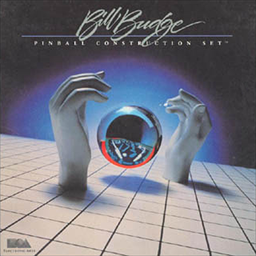
Pinball Construction Set is a video game by Bill Budge written for the Apple II. It was originally published in 1982 through Budge's own company, BudgeCo, then was released by Electronic Arts in 1983 along with ports to the Atari 8-bit family and Commodore 64.

Centipede is a 1980 fixed shooter arcade video game developed and published by Atari, Inc. Designed by Dona Bailey and Ed Logg, it was one of the most commercially successful games from the golden age of arcade video games and one of the first with a significant female player base. The primary objective is to shoot all the segments of a centipede that winds down the playing field. An arcade sequel, Millipede, followed in 1982.

Scott Adams is an American entrepreneur, computer programmer, and video game designer. He co-founded, with then-wife Alexis, Adventure International in 1979. The company developed and published video games for home computers. The cornerstone products of Adventure International in its early years were the Adventure series of text adventures written by Adams.

Raiders of the Lost Ark is an action-adventure game for the Atari 2600 released in 1982, based on the 1981 film of the same name. The game was designed by Howard Scott Warshaw.
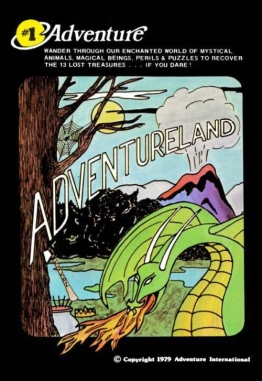
Adventureland is the first text adventure video game for microcomputers, released by Scott Adams in 1978. The game involves searching for thirteen lost artifacts in a fantasy setting. Its success led Adams to form Adventure International, which went on to publish thirteen similar games in the Adventure series, each in different settings.

Pirate Adventure is a text adventure program written by Scott Adams.
Datasoft, Inc. was a software developer and publisher for home computers founded in 1980 by Pat Ketchum and based out of Chatsworth, California. Datasoft primarily published video games, including home ports of arcade games, games based on licenses from movies and TV shows, and original games. Like competitor Synapse Software, the company also published other software: development tools, word processors, and utilities. Text Wizard, written by William Robinson and published by Datasoft when he was 16, was the basis for AtariWriter. Datasoft initially targeted the Atari 8-bit family, Apple II, and TRS-80 Color Computer, then later the Commodore 64, IBM PC, Atari ST, and Amiga. Starting in 1983, a line of lower cost software was published under the name Gentry Software.
Brian Howarth is a British video game designer and computer programmer. He wrote many interactive fiction computer games in the early 1980s in a series called Mysterious Adventures. He was born in Blackpool in 1953.
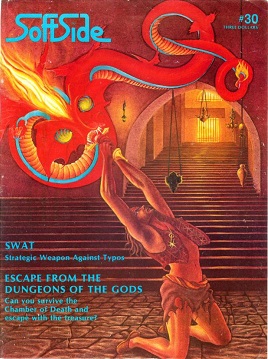
SoftSide is a defunct computer magazine, begun in October 1978 by Roger Robitaille and published by SoftSide Publications of Milford, New Hampshire.

Many games, utilities, and educational programs were available for the Atari 8-bit family of home computers. Atari, Inc. was the primarly publisher following the launch of the Atari 400/800 in 1979, then increasingly by third parties. Atari also distributed "user written" software through the Atari Program Exchange from 1981 to 1984. After APX folded, many titles were picked up by Antic Software.

Tutankham is a 1982 arcade video game developed and released by Konami and released by Stern in North America. Named after the Egyptian pharaoh Tutankhamun, the game combines a maze shoot 'em up with light puzzle-solving elements. It debuted at the European ATE and IMA amusement shows in January 1982, before releasing worldwide in Summer 1982. The game was a critical and commercial success and was ported to home systems by Parker Brothers.

Mystery Fun House is a text adventure game written by Scott Adams, "Adventure 7" in the series released by Adventure International. The player explores a fun house explore to locate a set of secret plans, solving puzzles along the way. Mystery Fun House was produced in only one week and was among the most difficult games in the series.
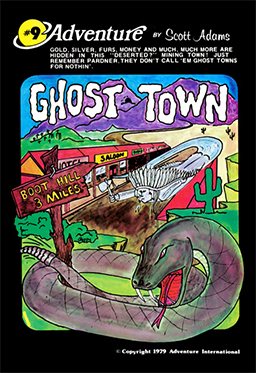
Ghost Town is a text adventure developed by Adventure International and released in 1980. It is part of the Adventure series of games developed by Scott Adams, preceded by Adventureland, Pirate Adventure, and Strange Odyssey.

Preppie! is an action video game for the Atari 8-bit family published by Adventure International in 1982. It was programmed by Russ Wetmore of Star Systems Software, whose name is prominently displayed on the box cover. Leaning on the preppy trend of the early 1980s, the game follows prep schooler Wadsworth Overcash as he navigates the hazards of a country club to retrieve golf balls. Preppie! borrows heavily from Konami's Frogger, with lanes of traffic in the bottom half of the screen and a river crossing the top portion. Alligators are an element from both Frogger and preppy fashion; an open-mouthed gator is the icon of shirt brand Izod. Reviewers recognized the game as derivative, but called the music and visuals some of the best for Atari 8-bit computers.
Russ Wetmore is an American programmer and video game designer best known for writing commercial games and applications for the Atari 8-bit family in the early to mid 1980s. His Frogger-inspired Preppie! was published by Adventure International as well as its sequel. He stopped writing games after the video game crash of 1983 and developed the integrated HomePak productivity suite for Batteries Included.

Scott Adams Scoops is a compilation of video games designed by Scott Adams and published by U.S. Gold for a variety of home computers: Pirate Adventure, Strange Odyssey, Voodoo Castle, and Buckaroo Banzai.

Empire of the Over-Mind is an interactive fiction game written by Gary Bedrosian and published by Avalon Hill for the Apple II, Atari 8-bit, and TRS-80 in 1981. A version with an enhanced display for DOS by Bedrosian was published in 1986.
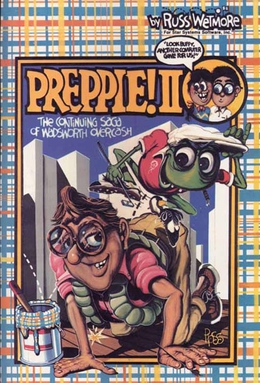
Preppie! II is a video game written by Russ Wetmore for the Atari 8-bit family and published by Adventure International in 1983. Subtitled "The continuing saga of Wadsworth Overcash," it is a sequel to 1982's Frogger-inspired Preppie!. It loosely follows the preppy theme, primarily through a story in the manual, but replaces the country club setting with an abstract, overhead view maze. Some obstacles from the first game appear in the second.
















